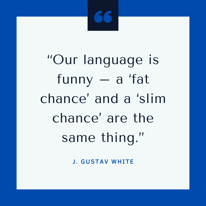 “Which” and “that” are sneaky little fellows. They’re both used to refer to places, things, and animals, but they’re not interchangeable. In fact, most people use them incorrectly without even realizing it.
“Which” and “that” are sneaky little fellows. They’re both used to refer to places, things, and animals, but they’re not interchangeable. In fact, most people use them incorrectly without even realizing it.
That is a big bummer, which I now intend to remedy.
This three-minute grammar lesson will solve the puzzle of “which” versus “that” for good.
When to Use That
“That” is used to introduce (or begin) essential clauses.
After reading that sentence, you’re probably sad, because “essential clauses” sounds like something to do with Christmas presents, but you’re pretty sure it doesn’t since this is a grammar blog. So you’re stuck even deeper in the mud of ignorance. Without presents.
In that case, let me pull you out and give you the gift of knowledge.
What an Essential/Restrictive Clause Is
An essential clause, also called a “restrictive clause,” is less intimidating than it sounds. It’s a part of a sentence that provides essential information about the noun (person, place, thing, or idea) that precedes it. In other words, the sentence wouldn’t be definitive or logically complete without it.
Here are some examples of essential clauses (in italics) beginning with “that”:
- This may be the only blog in the world that makes you laugh while teaching you grammar.
- I ate a huge cheese sandwich that gave me a stomachache.
- My neighbor’s is the only lawn that is decorated with ornate frog statues.
Try reading the sentences without the portions beginning in “that.” See how you don’t have the information you need in order to draw a conclusion? You need the rest of the sentence or the entire meaning changes. When you need the rest, use “that.”
When to Use Which
“Which” is used to introduce (or begin) nonessential clauses. These are Santa impersonators at an overstaffed North Pole.
…Okay, fine. The truth is much less interesting. But you’re not afraid now because you have already guessed what nonessential clauses are.
What a Nonrestrictive/Nonessential Clause Is
These are parts of a sentence we don’t need, but we like them. They give supplemental information — nice to know but not necessary for the sentence to be clear or make sense. These clauses typically are set off by commas.
Here are some examples of nonessential clauses (in italics) beginning with “which”:
- The cheese sandwich, which took me three hours to make, was piled four inches high.
- She was reading a blog post on grammar, which is the last thing she wanted to be doing.
- Our homeowner’s association, which we affectionately call “The Tattletale’s Glee Club,” told my neighbor to get rid of her frog statues.
When to Use Who Instead of Which or That
If you’re talking about a person (a pretty common thing to do) or the people who make up an entity/organization (less common), you can use “who” instead of “which” or “that.”
Some examples:
- My mom, who has never eaten a cheese sandwich, told me not to eat so much.
- You can guess that I, who never listens to my mother on matters of cheese, did not obey her order.
- The aforementioned frog statue-loving neighbor, who paid a pretty penny for those lawn ornaments, threw a fit over the HOA letter.
- The horse-breeding company who plays together, neighs together.
The Exception to the Rules
These rules apply to North American English. In the U.K., there is greater flexibility in these usages. Keep that in mind if you read widely or write for audiences in both locales.
Related Posts:



